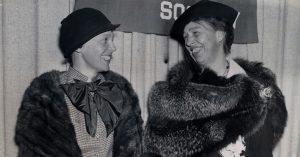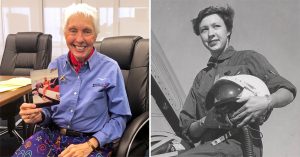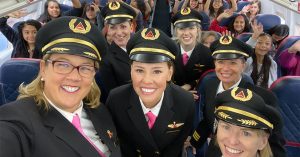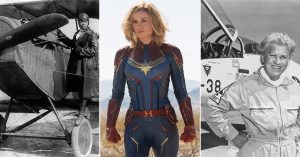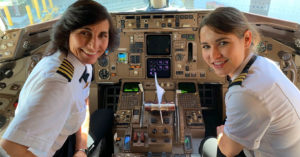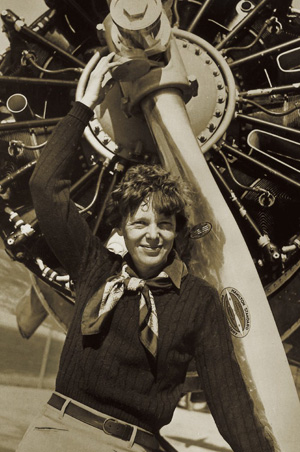 By Lili Sandler, A Mighty Girl Senior Research Intern
By Lili Sandler, A Mighty Girl Senior Research Intern
Amelia Earhart, the aviation pioneer, equal rights activist, and all around courageous heroine for generations of girls and women was born on this day in 1897. An icon of twentieth century bravery — but also that of mystery — Earhart is most well-known as the first woman to fly solo across the Atlantic Ocean, and to disappear during her attempted flight around the world.
As a child, Amelia Earhart had little to no interest in airplanes, but filled her days by exploring her neighborhood with her younger sister, reading voraciously, or following and collecting various critters found in her explorations. As a teen, Amelia kept a scrapbook filled with stories of women who were successful in careers dominated by men at the time.
After working as a nurse’s aide during World War I, Earhart went for her first ride in an airplane in 1920. It was that very flight — only ten minutes long, but that was all it took to change her life — that made Amelia Earhart say: “By the time I got two or three hundred feet off the ground, I knew I had to fly.”
On January 3, 1921, Amelia Earhart started flying lessons, and six months later, she owned her very own airplane, nicknamed “The Canary”. It was with that plane that she set a world record for female pilots in 1922, being the first to reach an altitude of 14,000 feet. On May 15, 1923, she became the 16th woman to receive a pilot’s license from the Fédération Aèronatique Internationale.
In April of 1928, Earhart received a phone call asking her if she’d like to be the first woman to fly across the Atlantic Ocean. While she was a passenger and not the the pilot of this June 1928 flight, its news coverage helped to promote her to a level of celebrity, leading to her nicknames of “Lady Lindy” or the “Queen of the Air”.
Over the next few years, Earhart became the first woman to fly solo across the North American continent and back, set a world altitude record, and helped to found and served as the first president of The Ninety-Nines, an organization of female pilots founded to support and advance women and their presence in aviation. Named for its first 99 members, the organization now boasts over 5,000 members in more than 30 countries.
![night-flight-amelia-earhart[1]](https://www.amightygirl.com/wp/wp-content/uploads/2013/07/night-flight-amelia-earhart1-299x300.jpg) In 1932, Amelia Earhart became the first woman to fly solo across the Atlantic Ocean, doing so in her iconic Lockheed Vega 5B, which is now on display at the Air and Space Museum in Washington, D.C. In recognition of her solo flight, she was given the Gold Medal by the National Geographic Society, the Distinguished Flying Cross by the United States Congress, and the Cross of the Knight of the Legion of Honor by the French Government.
In 1932, Amelia Earhart became the first woman to fly solo across the Atlantic Ocean, doing so in her iconic Lockheed Vega 5B, which is now on display at the Air and Space Museum in Washington, D.C. In recognition of her solo flight, she was given the Gold Medal by the National Geographic Society, the Distinguished Flying Cross by the United States Congress, and the Cross of the Knight of the Legion of Honor by the French Government.
Over the next few years, Earhart continued to set records, becoming the first woman to fly across the Pacific Ocean, which also made her the first person — male or female — to fly across both the Atlantic and the Pacific. In 1935, she joined the faculty at Purdue University, acting as a career counselor for young women and a technical adviser to the Department of Aeronautics. It was through this connection that she was able to finance the 1936 construction of her Lockheed Electra 10E airplane, modified to her own specifications. It was in this aircraft that she would attempt her “circumnavigation of the globe as near its waistline as could be."
With two men as her navigators, and a third as a technical adviser, Earhart took off in March of 1937 from Oakland, California, intending to make her way around the globe from east to west. However, when taking off from Pearl Harbor in Hawaii on the second leg of the journey, Earhart looped the plane on the runway for reasons that are still debated, causing significant damage to the Electra. The airplane had to be shipped back to the Burbank Lockheed facility to be repaired.
On her second attempt at global circumnavigation, Earhart had only one additional crew member, navigator Fred Noonan. The pair took off on June 1, 1937, from Miami, Florida, having reversed the direction of their flight due to weather patterns requiring them to fly from west to east. From North to Central to South America, the plane then crossed the Atlantic Ocean, the continent of Africa, the Indian Ocean, the Middle East, and much of Southeast Asia before landing in Papua New Guinea on June 29.
![51ANCFP4YBL[1]](https://www.amightygirl.com/wp/wp-content/uploads/2013/07/51ANCFP4YBL1-252x300.jpg) From there, Earhart and Noonan intended to fly the more than 2,500 miles to Howland Island, a small, flat island in the Pacific Ocean about halfway between Australia and Hawai’i. However, due to errors in radio communication that are still the subject of mystery and controversy, inadequate maps, overcast conditions, and insufficient fuel, the Electra never arrived at its intended destination.
From there, Earhart and Noonan intended to fly the more than 2,500 miles to Howland Island, a small, flat island in the Pacific Ocean about halfway between Australia and Hawai’i. However, due to errors in radio communication that are still the subject of mystery and controversy, inadequate maps, overcast conditions, and insufficient fuel, the Electra never arrived at its intended destination.
Beginning only an hour after Earhart’s last radio transmission on the second of July and continuing into the early fall, an exhaustive search mission was conducted which cost more than any search and rescue up to that time. Despite both official, government-run efforts as well as the privately-funded efforts of Earhart’s husband, George Putnam, no sign of pilot, navigator, or airplane were found.
There have been many theories explaining the disappearance of Earhart, Noonan, and the Electra, including the two most plausible explanations that either the duo crashed and perished in the Pacific Ocean or they landed on a reef near Gardner Island, now known as Nikumaroro, and survived there as long as they could. Researchers with The International Group for Historic Aircraft Recovery continue to investigate the area looking for evidence to support this theory, and while they have found several artifacts that could be proof of Earhart’s surviving a crash-landing, sufficient concrete evidence is still lacking.
However, news stories from as recently as June of this year tell of images of Gardner Island from 1938 that have recently been re-discovered, as well as sonar images of underwater objects that could be the wreckage from Earhart’s Electra. Undoubtedly, further investigations will take place that may lead to conclusions of just what did happen to Amelia Earhart after she was last heard from on July 2, 1937.
Amelia Earhart has been memorialized and honored in many ways and in many locations around the world. Her story is inspirational, and she has become an American icon and a symbol of courage and determination, especially for girls and women. She was truly a mighty girl, and we’re thrilled to wish her a very happy birthday.
![8719913[1]](https://www.amightygirl.com/wp/wp-content/uploads/2013/07/87199131-245x300.jpg) Many books have been published about Amelia Earhart, her life, and her legacy. To share the story of her solo flight across the Atlantic Ocean with young children, we recommend the book Night Flight: Amelia Earhart Crosses the Atlantic, by Robert Burleigh. With beautiful illustrations by Wendell Minor, the reader almost feels as though she’s Amelia’s co-pilot on her historical flight from Newfoundland to Ireland in 1932.
Many books have been published about Amelia Earhart, her life, and her legacy. To share the story of her solo flight across the Atlantic Ocean with young children, we recommend the book Night Flight: Amelia Earhart Crosses the Atlantic, by Robert Burleigh. With beautiful illustrations by Wendell Minor, the reader almost feels as though she’s Amelia’s co-pilot on her historical flight from Newfoundland to Ireland in 1932.
For a slightly older audience, consider the book Amelia Lost: The Life and Disappearance of Amelia Earhart. With chapters alternating between the story of Earhart’s life and the story of her disappearance and the subsequent search for any sign of her, readers 8 and up can immerse themselves in all things Amelia. A recipient of many four-starred reviews and other accolades, this book includes photos, maps, and even handwritten notes by Amelia herself.
A photobiography aimed at readers 10 and up, Corinne’s Szabo’s Sky Pioneer: A Photobiography of Amelia Earhart tells Earhart’s story through duotone photos, maps, and Earhart’s own writings. This biography focuses more on Earhart’s determination, life philosophies, and dedication to equality than on her disappearance or the mystery surrounding her final flight. An upbeat ode to Earhart’s adventurous spirit, this is a wonderful book for older children and adults alike.
For several other books for young readers about Earhart's fascinating life story, as well as Amelia Earhart costumes and a doll, visit A Mighty Girl's Amelia Earhart Collection.
Additional Recommended Resources
- To learn more about the groundbreaking life of Amelia Earhart, browse our Amelia Earhart Collection of books, toys, and costumes dedicated to the pioneering aviatrix.
- For stories of many women aviators and astronauts, browse our selection of books on pilots in our transportation category.
- For more stories of women explorers throughout history, visit our Explorers / Adventures section.
- To learn more about the organization The Ninety-Nines, visit http://www.ninety-nines.org










